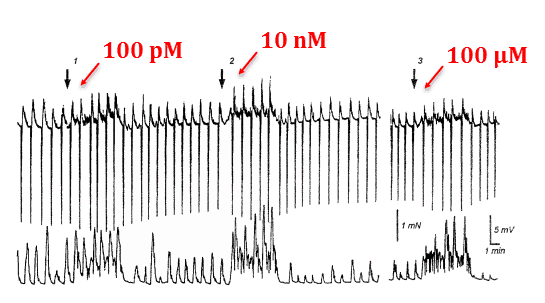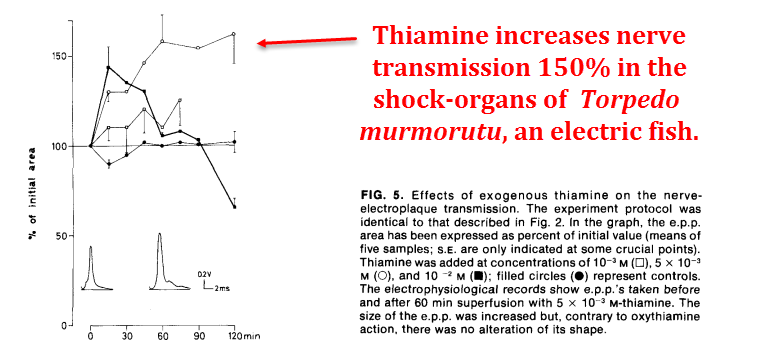
Studies keep proving that thiamine is one of the most important vitamins for preventing Alzheimer’s
—-Important Message From Our Sponsor—-
73-year-old grandpa fixes 20 years of back pain by doing THIS

Brand-new research has revealed the #1 way for people over 40 to reverse back pain.
Can you guess what it is? Click on your answer:
———-
Eat these foods rich in thiamine to keep your memory strong
Our bodies need thiamine (vitamin B1) for the maintenance of the nerves and the brain.
In fact, our nervous system needs it so much that that beriberi – a thiamine deficiency disease – lists polyneuritis as the main diagnostic criteria.
Neuritis is caused by the demyelination of nerves, the most characteristic location of thiamine’s function.
Because of the brain-specific manifestations seen during dietary deficiency, most early thiamine research was conducted in relation to the nervous system.
Thiamine deficiency also causes muscle weakness, atrophy, pain, etc…
Yet these can all be explained as being subsequent to the initial denervation.
Even though thiamine has a general pro-metabolic effect, it is also somewhat specific to nerves…
Thiamine acts at synapses to increase acetylcholine (ACh) for nervous transmission.
As with vitamin C, potassium, and folate, the RDA for thiamine is currently set rather low – only 1.2 mg.
And, because so many common foods are somewhat deficient in this vitamin and lose some of it during cooking, even the criminally low RDA cannot be taken as given.
Nor is thiamine one of the B vitamins commonly added to energy drinks.
This means that thiamine is one of the few B vitamins that we must actively seek, especially considering how important it is.
Sure, we can get by on the small RDA-sized amounts.
But studies show that giving average people more thiamine invariably has positive effects.
The characteristic effect of thiamine in relation to the nerves can be understood by noting its mechanism of action.
Numerous studies on this topic have yielded many proposed mechanisms, yet there is really only one that should occur at physiological concentrations.
“The results suggest that high-dose oral thiamine has an active pharmacological effect on central cholinergic systems.” (Meador, 1993)
At unrealistically high doses, thiamine inhibits the enzyme choline acetyltransferase (ChAT), thereby sparing ACh and increasing nerve potential.
Although this would rationally explain the sort of effect thiamine is noted for, the concentration required for it to work this way can only be achieved through IV injection.
The results of other studies are equally dubious for the same reason.
Yet, regardless of the alternative explanations, the classic observation of thiamine having a pro-cholinergic effect cannot be denied.
Studies demonstrating this effect date back to 1938. And there have been dozens of verifications published since.
In fact, our knowledge of thiamine’s characteristic involvement in the nervous system dates back to the 19th century.
At that time, symptoms accompanying beriberi, another line of research, were discovered quite incidentally.
Later, during pre-WWII nerve research, they inferred that something had been interfering with the ACh measurements…
And that “something” turned out to be thiamine (Minz, 1938).
This stimulated a host of research proving that thiamine is released by nerves along with ACh.
They also discovered back then that its destruction by shortwave UV explains why only certain frequencies of light inhibit nerves.
“…it was obvious in 1938 that another unknown factor was interfering with the determination of acetylcholine (ACh), especially in nerve extracts… As soon as Minz published his results it became clear that thiamine might be interfering in the determination of ACh.” (von Muralt, 1947)
Thiamine is so important that it was one of the first vitamins isolated, second only to vitamin A. Hence the name B1.
In fact, its discovery helped shape the very concept of the term vitamin…
And that is something along the lines of “an indispensable molecule found in food, the deficiency of which produces a disease.”
Wernicke’s encephalopathy, Korsakoff syndrome, and Beriberi…
These are three thiamine deficiency diseases fundamentally differing only by country – Germany, Russia, and Sri Lanka respectively.
Of course thiamine deficiency knows nothing of national boundaries…
Its deficiency is so easy to induce and symptoms are so extreme that it has been noted as occurring nearly anywhere.
It happens to Americans too, especially those who eat too much refined food or drink too much alcohol or tea – which reduces its absorption slightly.
“Although the importance of thiamine is widely appreciated and it is readily available for clinical use, thiamine deficiency still remains a major health problem not only in underdeveloped countries but also in the richer more industrialized nations.”
Thiamine is ultimately needed for many functions within the body, not the least of which is to increase ACh for nerve conduction and strength.
For this reason, and the low concentrations found in common foods, thiamine supplements can be seen as a veritable nootropic drug.
Thiamine supplements will act to enhance cognition in most Americans because of their relatively low dietary intake.
And it is as important for thinking as it is for reaction time.
Thiamine was shown to increase reaction time as long as 70 years ago (Tuttle, 1949).
Thiamine’s nootropic effect is a foregone conclusion, really.
And the neurological symptoms that occur with the classic deficiency diseases are fundamentally just manifestations of ACh deficiency.

The strength of evidence for this is rather high:In this 1993 study, they recruited 13 healthy people ranging between 23 and 35 years of age to determine if thiamine could offset scopolamine, a nightshade alkaloid similar to atropine.
Atropine and scopolamine can both effectively bind ACh receptors without potentiating the nerves, all while blocking the ability of ACh to do so.
They gave all 13 participants scopolamine on two occasions, one week apart.
One of those doses was preceded by a 5 gm dose of thiamine administered three hours beforehand.
The researchers tested the subjects with electroencephalograms while the subjects performed tasks…
And they determined that thiamine could act as a partial antidote to the scopolamine, effectively antagonizing the anti-cholinergic drug:

Thiamine also shortened the onset of P300 waves, as measured electroencephalographically.
These “brain waves” are:
(1) Involved in decision making
(2) Best measured near the parietal lobe
(3) Named P300 on account of manifesting approximately 300 milliseconds after stimulus
Thiamine cut 23 milliseconds off the 48-millisecond delay caused by scopolamine, and increased the P300 wave’s amplitude by 1.03 μV2.
The P300 waves are specifically under the influence of cholinergic drugs, not adrenergic ones.
The fact that thiamine was capable of modifying P300 waves is strong support of a cholinergic effect…though hardly a novel observation as late as 1993.
“The cognitive effects of the anticholinergic scopolamine were partially reversed by high-dose thiamine as evidenced by alterations in the P300 event-related potential, spectral EEG, and memory performance. The results suggest that high-dose oral thiamine has an active pharmacological effect on central cholinergic systems.”
For this research, they chose to use a 5 gm dose of thiamine based on previous amounts used to treat Alzheimer’s.
And that dose worked considerably better than 3 gm.
Although five gm might seem excessive, this is about the amount contained in an unrefined and uncooked diet.
Doses not exceeding 10 gm per day have been proven safe… It’s only the much lower RDA value for thiamine that makes 5 gm seem high.
Millions of wild animals eat these amounts and more daily – after adjusting for body weight – and are living testament to the safety of thiamine.
“Thiamine appears to be involved in the process of ACh release from the presynaptic junction.”
This is strong support of the pro-cholinergic effect of thiamine.
And many other studies when taken in conjunction with this one pretty much prove it.
Just like ACh, thiamine induces a direct effect on muscle at low concentrations:

Yet thiamine does take a few minutes to act, all but ruling out any of the direct neurotransmitter effects that are attributed by some scientists.
Some animals, such as electric eels and stingrays, have triple-digit micromolar concentrations of thiamine in their systems.
But humans only have high nanomolar to low micromolar concentrations in their brains.
“In some vertebrates, the level of thiamine and thiamine monophosphate in blood plasma and spinal fluid can reach 100 nM.” (Romanenko, 1994)
So humans cannot achieve thiamine concentrations necessary to do any other function besides the classic one as an enzymatic cofactor – even with a determined supplementation regime.
And, incidentally, thiamine increases the nerve potential in stingrays.
Those electric fish are often used in ACh research due to the high levels they have.

Thiamine is a cofactor for pyruvate carboxylase, an enzyme that transforms pyruvate into carbon dioxide and acetate.
Although carbon dioxide certainly has its effects, it is the acetate produced by this process that is of concern here.
The acetate is liberated by pyruvate carboxylase in the presence of its thiamine cofactor.
And it eventually makes its way to ACh through an intermediate called acetyl-coenzyme A (acetyl-CoA).
Acetyl-CoA is a substrate for choline acetyltransferase (ChAT).
And ChAT is the enzyme that synthesizes ACh directly from its two precursors.
This mechanism is supported by the low concentrations of thiamine needed for the effect – and also by the minute-long time delays noted by Romanenko (above).
The idea that thiamine’s classic function as a cofactor for pyruvate carboxylase is likely responsible for its cholinergic effects was suggested as far back as the mid-1940s (Nachmansohn, 1945).
“…[Nachmansohn] mentions…that the acetyl portion of acetylcholine (ACh) is derived from pyruvic acid and that cocarboxylase (thiamine) plays an important role in the oxidation of pyruvic acid…” (von Muralt, 1947)
“Nachmansohn and Steinbach (1942) found that the vitamin, determined as di-phospho-thiamine, is concentrated at the surface of the axoplasm and, therefore, is close to the region where ACh metabolism takes place.” (von Muralt, 1947)
This could imply that dietary choline, the other precursor, would be equally important.
In fact, choline has been shown to increase brain ACh concentrations.
In addition, the enzyme pyruvate decarboxylase needs alpha-lipoic acid for full activity.
Alpha-lipoic acid technically functions as an enzyme-bound prosthetic group in pyruvate decarboxylase.
These bound molecules are necessary for the formation of acetyl-CoA.
Although not strictly vitamins, both choline and alpha-lipoic acid could be thought to synergize with thiamine towards ACh synthesis.
Choline is, of course, presumed safe… It’s in egg yolks.
And the only caveat of taking alpha-lipoic acid appears to stem from its ability to chelate “soft metals” (e.g. lead and mercury), potentially redistributing them.
Anyone who thinks they may be high in these metals could consider taking water-soluble chelators before taking alpha-lipoic acid…
These are excreted more quickly, and ionized ones generally don’t cross the blood-brain barrier.
It’s very difficult to get enough thiamine from food.
And you might be avoiding some of the foods that contain it for a variety of reasons.
Here are some foods rich in thiamine:
- Eggs
- Beef steak and pork
- Wheat germ
- Trout and Bluefin tuna
- Legumes and peas
- Nuts and seeds
- Enriched, fortified, and whole grain products such as bread, cereals, rice, pasta, and flour
To your health!
—-Important Message—-
This odd food gives men a stiff “tent pole” again

No matter how long it’s been since you’ve had a thick, hard “tent pole” between your legs…
…you can get one whenever you want just from this one food…weird, isn’t it?
And why haven’t you heard of this food!
———-
